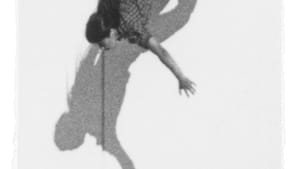Stay in the Loop
BSR publishes on a weekly schedule, with an email newsletter every Wednesday and Thursday morning. There’s no paywall, and subscribing is always free.
Falling
Sarah Charlesworth: Stills at the Chicago Art Institute

Around 1:30AM on a day in June of 1983, a 100-foot section of Interstate 95 collapsed, causing two cars and two tractor-trailers to fall 70 feet into the Mianus River near Greenwich, Connecticut. Three people were killed and another three critically injured. The driver of a BMW reported that he came to a halt at the edge of the abyss, after seeing the car in front of him disappear. Living in Boston at the time, often driving to New York via I-95, I remember cringing at the news and wondering, heaven help us, what the people must have felt like, driving along in the dark of night and all of a sudden hurtling in space. A few months later, I moved to Philadelphia via an alternate route.
I used to have a boyfriend who was afraid of heights. By way of helping this otherwise tall and brave enough fellow, I invited him for a walk across Philadelphia’s Ben Franklin Bridge. He both clung to me and managed to get over and back. I’m not afraid of heights, though looking down from a high-rise apartment does engender a wave of eerie energy that feels like an invitation to jump. This I decline.
Some people do jump. I have a friend whose beloved sister (a comic solo-performance artist in Sante Fe) disappeared in the summer of 2003. Two weeks later, a fisherman found her body in the Rio Grande. She had jumped off the 565-foot high Gorge Bridge, the seventh highest bridge in the United States and a wonder to behold, just outside Taos.
I’ve contemplated the psycho-spiritual motivation of jumping. It seems connected to a desire to join the vastness of space: to be enveloped in space, or lost in the deep infinitude of space; to cast off the claustrophobia of self, or open to illumination; and to fly. Wanting to jump seems opposite to being afraid of heights. Fear of heights may arise from a paralyzing fear of space; that is, clinging to the cocoon of self and scared to open.
Before ubiquitous digital photography
On a recent visit to the great city of Chicago, on the ground floor of the grand and noble edifice that is the Chicago Art Institute, I experienced a photography exhibit of persons who have jumped from high places. Entitled “Stills,” the exhibit features 14 works by Sarah Charlesworth (1947-2013), full-length portraits of men and women falling through space.
 More than 30 years ago, well before pocket digital and cell phone cameras, Ms. Charlesworth searched decades of news services and the archives of the New York Public Library for pictures of persons who had leapt from life-threatening heights. She found and bought 14 of them. She cropped away any sign of the point of origin of the leap as well as a potential point of landing, leaving the body suspended. She tore or frayed the edges of the image to disassociate it from the look of professional media. She pasted the image on mat board and re-photographed it. Then she blew it up, enlarging the newsprint-size image to measure 6.5 feet high by 3.5 feet wide. What she manifested with the finished work, in the vanguard of large-scale photography, was mural-size photos of bodies in the process of dying from falling.
More than 30 years ago, well before pocket digital and cell phone cameras, Ms. Charlesworth searched decades of news services and the archives of the New York Public Library for pictures of persons who had leapt from life-threatening heights. She found and bought 14 of them. She cropped away any sign of the point of origin of the leap as well as a potential point of landing, leaving the body suspended. She tore or frayed the edges of the image to disassociate it from the look of professional media. She pasted the image on mat board and re-photographed it. Then she blew it up, enlarging the newsprint-size image to measure 6.5 feet high by 3.5 feet wide. What she manifested with the finished work, in the vanguard of large-scale photography, was mural-size photos of bodies in the process of dying from falling.
Well, not quite all are dying. One photo is of a stunt fall. The others are genuine in the sense of depicting (likely) non-survivors. The Stills exhibit brings all 14 of Ms. Charlesworth’s black-and-white photos together for the first time. (Some were shown in 1980.) Nine of the subjects are men and five are women. Five are identified by name. The place of the event, from L.A. to Ankara, is recorded in all but three.
Room for empathy
While sensationalism could be attendant upon the exhibit, there is substantial room for empathy to emerge in the viewer. In observing the images, I didn’t feel like I was witnessing the actual fallings. A falling had happened, and here was its artistic imprint outside of time. But as I stayed with each image, I began to feel close to the person falling and interested in who he or she was. I didn’t need to know why the person had jumped, though that of course crossed my mind, if indeed he or she had jumped. It’s possible some may have fallen accidentally or been pushed. I was not intent on imagining their stories. But I did want to know their names, if only to say, “Hello, Mr. ________.” “Hello, Ms. _______.” I wanted to wish them well in whatever was coming next.
The value of Stills rests in the artist’s metaphysical accomplishment: bringing reverence to the act of falling. In 13 of the pictures, I was looking at someone dying. I was seeing a unique death, something private, in which the person was entirely alone — whether witnessed or not, then or now. That is, of course, how dying will be for all of us: encountered alone.
Standing there in the gallery, I concluded that no one could rightfully conjure a good reason to look down upon or judge the people who chose to jump. (We are in fact looking up at them in the photos, or existing on a level with them.) The Stills exhibit is free of the indecency of condoning or condemning. We the spectators, like the artist Sarah Charlesworth before us, can quiet negative thoughts in the presence of these falling persons. We can feel the gravity and solemnity of falling, along with the suffering.
One day in September
Experiencing these pre-1980s photos, it’s impossible not to fast forward to the first year of the 21st century, unthinkable not to remember the sight of falling bodies on 9/11. Coincidentally, just before traveling to Chicago, I visited the soaring new World Trade Center. Most startling was the image of a passing plane reflected on the massive glass exterior of Tower One — uncanny, unnerving déjà vu, as if viewing a reenactment.
After Stills in Chicago, I researched the phenomenon of 9/11 falling bodies and found an unofficial estimate: 200 people dropped into the sky of lower Manhattan in less than 100 minutes. They jumped from the hot hell and suffocating smoke of the burning towers. They fell trying to climb to another floor. They tripped, wandered, or blindly stepped out the cavernous holes. During my research, I came upon a decent video made from fragments of footage of people falling. To watch the video is to honor the fallen.
Above right: Sarah Charlesworth. Unidentified Man, Ontani Hotel, Los Angeles, 1980. (© Estate of Sarah Charlesworth; courtesy the Estate of Sarah Charlesworth and Maccarone.)
What, When, Where
Sarah Charlesworth: Stills. Through January 4, 2015 at Chicago Art Institute, Gallery 188, 111 South Michigan Avenue, Chicago. http://www.artic.edu
Sign up for our newsletter
All of the week's new articles, all in one place. Sign up for the free weekly BSR newsletters, and don't miss a conversation.

 Joanna Rotté
Joanna Rotté